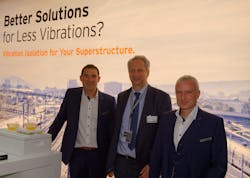Getzner Presents Optimized Solutions for Turnouts and Transitions
As trains travel along the track, vibrations and impacts are generated, which are then transferred to the railway superstructure. In order to protect the individual superstructure components from these loads and their consequences, such as excessive wear, Getzner has developed a range of solutions.
"Transitions and turnouts are areas of the railway track that require a lot of maintenance work. They have a significant influence on the efficiency of a track, as they determine its availability. On average, turnouts account for only one percent of the investment costs, however are responsible for a quarter of the maintenance costs," stressed Stefan Potocan, head of product management at Getzner.
"At InnoTrans, we have shown how we can optimize critical areas, such as transitions and turnouts, with our products. High track maintenance costs are a burden to our customers, which is why we brought this issue to the fore at the trade fair," explained Juergen Rainalter, chief executive officer of Getzner.
Gotthard Base Tunnel: cooperation on high-speed turnouts
At InnoTrans, Getzner showcased an elastic solution for turnouts that is placed under high strain: the high-speed turnouts in the Gotthard Base Tunnel developed in conjunction with voestalpine Weichensysteme. The demands on track availability for this once-in-a-century project are simply enormous. Up to 250 trains a day (approximately ten trains per hour) will travel along the high-speed line at speeds of up to 250 km/h and axle loads of up to 25 t – and this is set to continue for decades. Erich Wipfler from voestalpine Weichensysteme and Stefan Potocan from Getzner gave an insight into the challenges involved in this major project at a press showcase on September 21 on the Getzner stand.
Elastic components compensate for variations in stiffness
Almost every railway track consists of different types of superstructure and sits on different subsoil. For example, an open track goes over a bridge, a slab track changes into a ballast section, etc. This is why every railway line has problematic and less problematic areas in terms of wear. At turnouts and transitions, the superstructure is subjected to particularly high loads, as high dynamic forces are exhibited and different subsoil stiffness meet in these areas – a slab track made of concrete naturally has less elasticity than a ballasted track. The loads caused by sudden variations in stiffness are highest here, which is why the most wear occurs and maintenance costs are highest in these areas. The highly elastic components made of Getzner's materials Sylomer and Sylodyn – developed and manufactured in house – compensate for these stiffness differences in the superstructure.
The right amount of elasticity for every section of the track
Getzner simulates the loads when a train passes using the "Finite Element Method (FEM)". With the help of forecast models, Getzner determines precisely which solutions should be used for which section. This means in addition to standard products, Getzner can also offer customized system solutions. Using a precise and individual calculation, the effectiveness of the elastic bearing is clear to see: "There is less wear to the superstructure components, which in turn reduces the need for maintenance. By using a defined amount of elasticity, the life cycle costs of a line can be considerably reduced," summarized Potocan.
Interactive: the train pulls in to the stand
"Vibrations" could be experienced interactively on Getzner's trade fair stand, as every 30 minutes a virtual train passed by. At so-called "hot spots" visitors were able to experience the effects of vibrations first hand. Models were also used to showcase floating floors for rolling stock, such as those used in the Hitachi trains for the British Intercity Express Programme. Getzner's established standard products, including under ballast mats, mass-spring systems and sleeper pads, were also on show. For example, a new, full-size sleeper model demonstrated how the elastoplastic bearings protect the ballast from premature destruction by increasing the contact area. Getzner was awarded the Vorarlberg advertising prize "AdWin" in 2015 in the "Communication in space" category for its vibrating trade fair stand.
